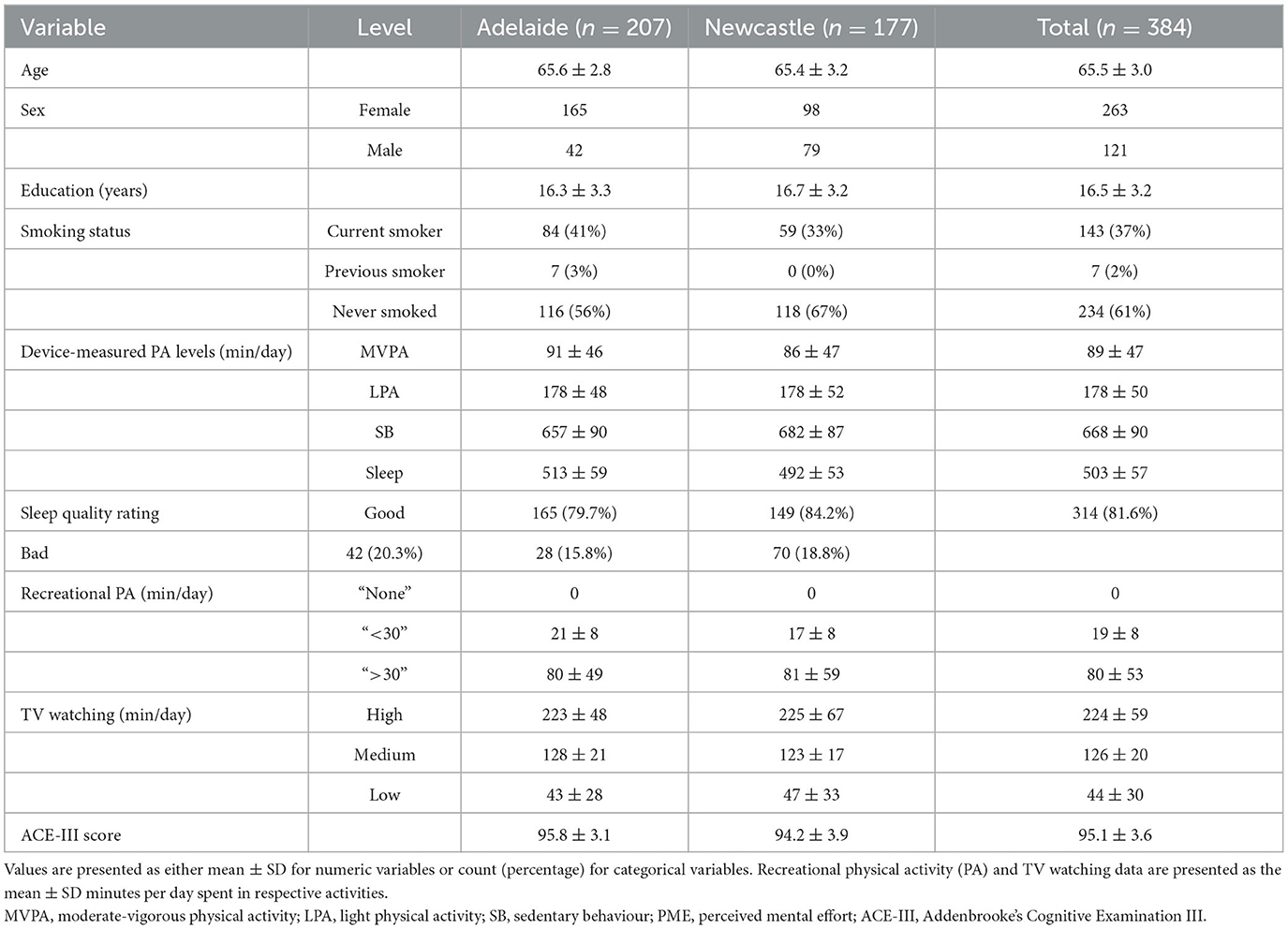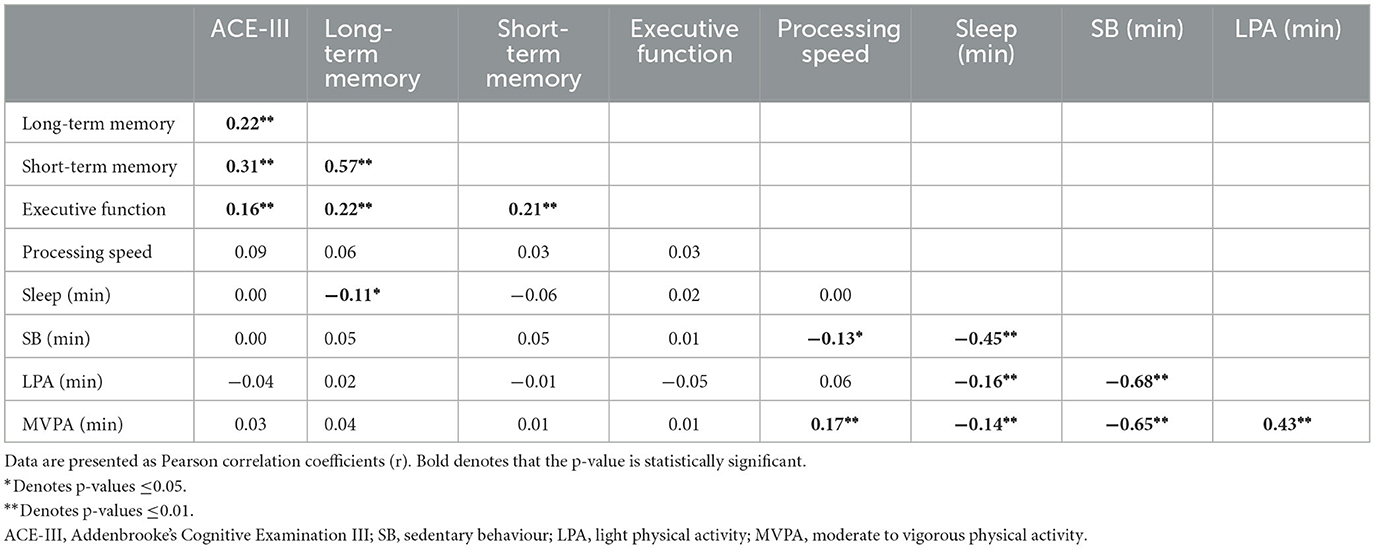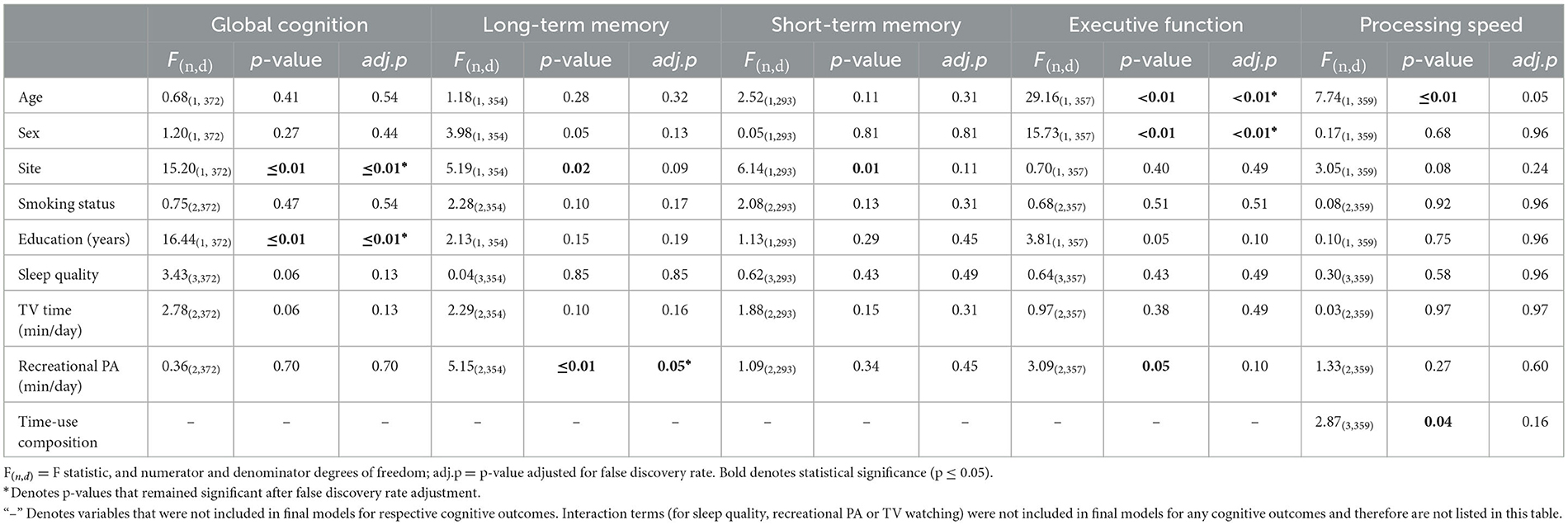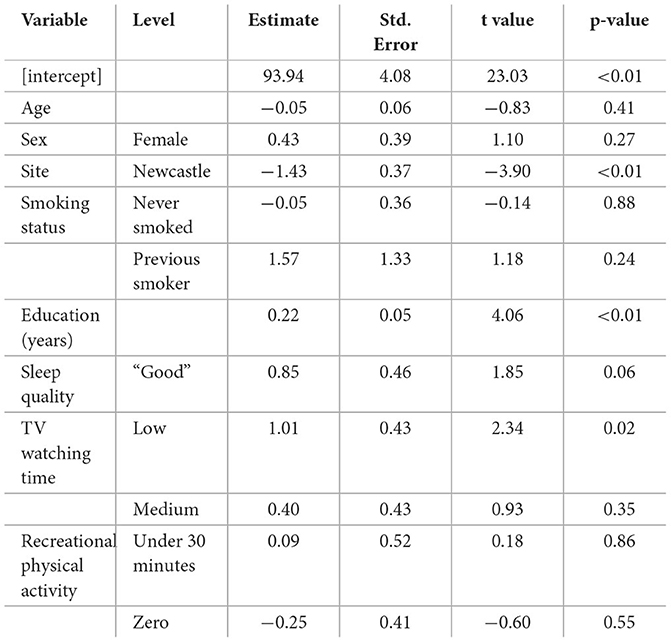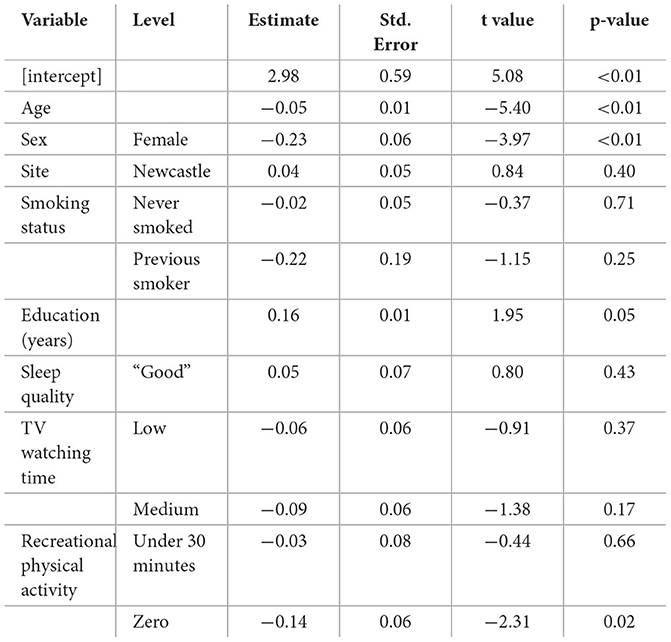- 1Alliance for Research in Exercise, Nutrition and Activity, Allied Health and Human Performance, University of South Australia, Adelaide, SA, Australia
- 2Functional Neuroimaging Laboratory, School of Psychological Sciences, The University of Newcastle, Newcastle, NSW, Australia
- 3Healthy Minds Research Program, Hunter Medical Research Institute (HMRI), Newcastle, NSW, Australia
- 4Behaviour-Brain-Body Research Centre, Justice and Society, University of South Australia, Adelaide, SA, Australia
- 5Lifespan Human Neurophysiology Group, School of Biomedicine, University of Adelaide, Adelaide, SA, Australia
- 6Hopwood Centre for Neurobiology, Lifelong Health Theme, South Australian Health and Medical Research Institute (SAHMRI), Adelaide, SA, Australia
A corrigendum on
Twenty-four-hour time-use composition and cognitive function in older adults: cross-sectional findings of the ACTIVate study
by Mellow, M. L., Dumuid, D., Wade, A. T., Stanford, T., Olds, T. S., Karayanidis, F., Hunter, M., Keage, H. A. D., Dorrian, J., Goldsworthy, M. R., and Smith, A. E. (2022). Front. Hum. Neurosci. 16:1051793. doi: 10.3389/fnhum.2022.1051793
In the published article, there were several errors in Table 2 as published. The mean ACE-III scores presented for Adelaide participants, Newcastle participants and the total sample were presented incorrectly due to errors in the calculation of ACE-III scores. The corrected Table 2 and its caption appear below.
In the published article, there were several errors in Table 3 as published. Correlations between executive function and other outcomes were incorrect due to an error in the calculation of the executive function composite score, and correlations between ACE-III score and other outcomes were incorrect due to minor errors in the calculation of the ACE-III scores. The corrected Table 3 and its caption appear below.
In the published article, there were several errors in Table 4 as published. ANOVA type II F-test outcomes for executive function were incorrect due to an error in the calculation of the executive function composite score, and ANOVA type II F-test outcomes for ACE-III score were incorrect due to errors in the calculation of ACE-III scores. The corrected Table 4 and its caption appear below.
In the published article, there was an error in Supplementary Material 3 (Table 1). The linear regression output for the global cognition outcome was based on incorrect data due to error in calculation of ACE-III total scores. The correct material appears below.
Global cognition
Final model: global cognition ~ age + sex + site + smoking status + education + sleep quality + TV watching time + recreational physical activity
In the published article, there was an error in Supplementary Material 3 (Table 4). The linear regression output for the executive function outcome was based on incorrect data (due to error in calculation of executive function composite score). The correct material appears below.
Executive function
Final model: executive function ~ age + sex + site + smoking status + education + sleep quality + TV watching time + recreational physical activity
In the published article, a number of statements were made about global cognition and executive functions outcomes which were based on incorrect data. We have now corrected the data and have subsequently altered a number of text sections to reflect the correct findings for global cognition and executive functions outcomes.
A correction has been made to Section 3.1, Participant demographics, paragraph 1. This sentence previously stated:
“A number of participants were removed from each analysis due to missing cognitive data: total samples for each cognitive outcome included: n = 372 for global cognition; n = 292 for short-term memory; n = 353 for long-term memory; n = 356 for executive functions; n = 358 for processing speed.”
The corrected sentence appears below:
“A number of participants were removed from each analysis due to missing cognitive data: total samples for each cognitive outcome included: n = 384 for global cognition; n = 292 for short-term memory; n = 353 for long-term memory; n = 369 for executive functions; n = 358 for processing speed”.
A correction has been made to Section 3.2.1, Pairwise correlations, paragraph 1. This sentence previously stated:
“Pearson correlation coefficients revealed that time spent in sleep was negatively correlated with long term memory (r = −0.11, p = 0.03) and executive function (r = −0.12, p = 0.02), time spent in sedentary behaviour was negatively correlated with processing speed (r = −0.13, p = 0.01), and time spent in MVPA was positively correlated with processing speed (r = 0.17, p < 0.01).”
The corrected sentence appears below:
“Pearson correlation coefficients revealed that time spent in sleep was negatively correlated with long term memory (r = −0.11, p = 0.03), time spent in sedentary behaviour was negatively correlated with processing speed (r = −0.13, p = 0.01), and time spent in MVPA was positively correlated with processing speed (r = 0.17, p < 0.01).”
A correction has been made to Section 3.2.2, Linear regression models, paragraph 1. This sentence previously stated:
“Additionally, several covariates were significantly associated with cognitive outcomes: older age was associated with better executive function (β = 0.02) and slower processing speed (β = −0.38); site was negatively associated with global cognition (β = −1.01) and positively associated with long-term memory (β = 0.25) and short-term memory (β = 0.17) (i.e., participants from Newcastle had lower global cognition scores and higher long-term and short-term memory scores than Adelaide); higher education (years) was associated with better global cognition (β = 0.18); and engaging in no recreational physical activity (relative to >30 min) was associated with poorer long-term memory (β = −0.38).”
The corrected sentence appears below:
“Additionally, several covariates were significantly associated with cognitive outcomes: older age was associated with poorer executive function (β = −0.05) and slower processing speed (β = −0.04); site was negatively associated with global cognition (β = −1.43) and positively associated with long-term memory (β = 0.25) and short-term memory (β = 0.17) (i.e., participants from Newcastle had lower global cognition scores and higher long-term and short-term memory scores than Adelaide); higher education (years) was associated with better global cognition (β = 0.22); sex (being female) was negatively associated with executive function (β = −0.23) and engaging in no recreational physical activity (relative to >30 min) was associated with poorer long-term memory (β = −0.38).”
A correction has been made to Section 3.2.2, Linear regression models, paragraph 2. This sentence previously stated:
“After false discovery rate adjustment, none of the associations between 24-h time-use composition and cognitive function outcomes were statistically significant. Associations between age and processing speed, recreational physical activity and long-term memory, as well as education, site and global cognition, remained significant. Unadjusted and adjusted p-values for all variables across each cognitive outcome are displayed in Table 4. Linear regression outputs for each cognitive outcome can be found in Supplementary material 3”.
The corrected sentence appears below:
“After false discovery rate adjustment, none of the associations between 24-h time-use composition and cognitive function outcomes were statistically significant. Associations between age and executive functions, recreational physical activity and long-term memory, sex and executive functions, as well as education, site and global cognition, remained significant. Unadjusted and adjusted p-values for all variables across each cognitive outcome are displayed in Table 4. Linear regression outputs for each cognitive outcome can be found in Supplementary material 3”.
A correction has been made to Section 4.1, 24-hour time use composition and cognitive function in older adults, paragraph 1. This sentence previously stated:
“We initially explored pairwise correlations to understand the independent and unadjusted associations between time use variables and cognitive outcomes, in which we found that sleep was negatively correlated with long-term memory and executive function, sedentary behaviour was negatively correlated with processing speed, and MVPA was positively correlated with processing speed. Subsequently, after adjusting for demographic and health factors that are associated with risk of dementia (age, sex, education, smoking status), linear regression models demonstrated 24-h time-use composition was significantly associated with processing speed, but there were no associations with global cognition, long-term memory, short-term memory or executive function.”
The corrected sentence appears below:
“We initially explored pairwise correlations to understand the independent and unadjusted associations between time use variables and cognitive outcomes, in which we found that sleep was negatively correlated with long-term memory, sedentary behaviour was negatively correlated with processing speed, and MVPA was positively correlated with processing speed. Subsequently, after adjusting for demographic and health factors that are associated with risk of dementia (age, sex, education, smoking status), linear regression models demonstrated 24-h time-use composition was significantly associated with processing speed, but there were no associations with global cognition, long-term memory, short-term memory or executive function.”
The authors apologize for these errors and state that these do not change the scientific conclusions of the article in any way. The original article has been updated.
Publisher's note
All claims expressed in this article are solely those of the authors and do not necessarily represent those of their affiliated organizations, or those of the publisher, the editors and the reviewers. Any product that may be evaluated in this article, or claim that may be made by its manufacturer, is not guaranteed or endorsed by the publisher.
Keywords: time use, cognitive function, ageing, sleep, sedentary behaviour, physical activity
Citation: Mellow ML, Dumuid D, Wade AT, Stanford T, Olds TS, Karayanidis F, Hunter M, Keage HAD, Dorrian J, Goldsworthy MR and Smith AE (2023) Corrigendum: Twenty-four-hour time-use composition and cognitive function in older adults: cross-sectional findings of the ACTIVate study. Front. Hum. Neurosci. 17:1221303. doi: 10.3389/fnhum.2023.1221303
Received: 12 May 2023; Accepted: 26 May 2023;
Published: 09 June 2023.
Edited and reviewed by: Ryan Stanley Falck, University of British Columbia, Canada
Copyright © 2023 Mellow, Dumuid, Wade, Stanford, Olds, Karayanidis, Hunter, Keage, Dorrian, Goldsworthy and Smith. This is an open-access article distributed under the terms of the Creative Commons Attribution License (CC BY). The use, distribution or reproduction in other forums is permitted, provided the original author(s) and the copyright owner(s) are credited and that the original publication in this journal is cited, in accordance with accepted academic practice. No use, distribution or reproduction is permitted which does not comply with these terms.
*Correspondence: Maddison L. Mellow, bWFkZGlzb24ubWVsbG93QG15bWFpbC51bmlzYS5lZHUuYXU=
 Maddison L. Mellow
Maddison L. Mellow Dorothea Dumuid1
Dorothea Dumuid1 Alexandra T. Wade
Alexandra T. Wade Timothy S. Olds
Timothy S. Olds Frini Karayanidis
Frini Karayanidis Montana Hunter
Montana Hunter Hannah A. D. Keage
Hannah A. D. Keage Jillian Dorrian
Jillian Dorrian Ashleigh E. Smith
Ashleigh E. Smith